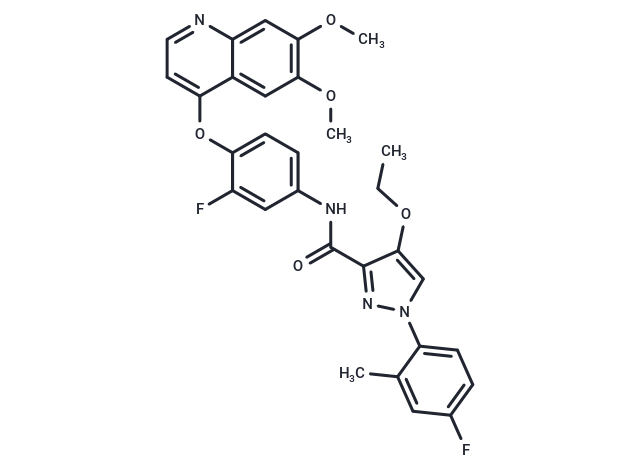Shopping Cart
- Remove All
 Your shopping cart is currently empty
Your shopping cart is currently empty

LDC1267 is a excellently specific TAM(Tyro3, Axl and Mer) kinase inhibitor, for Mer( IC50<5 nM), Tyro3(IC50=8 nM), and Axl(IC50=29 nM).

| Pack Size | Price | Availability | Quantity |
|---|---|---|---|
| 1 mg | $30 | In Stock | |
| 2 mg | $44 | In Stock | |
| 5 mg | $70 | In Stock | |
| 10 mg | $107 | In Stock | |
| 25 mg | $177 | In Stock | |
| 50 mg | $261 | In Stock | |
| 100 mg | $441 | In Stock | |
| 1 mL x 10 mM (in DMSO) | $85 | In Stock |
| Description | LDC1267 is a excellently specific TAM(Tyro3, Axl and Mer) kinase inhibitor, for Mer( IC50<5 nM), Tyro3(IC50=8 nM), and Axl(IC50=29 nM). |
| Targets&IC50 | Tyro3:8 nM, Mer:<5 nM, Axl:29 nM |
| In vitro | In mice bearing B16F10 melanoma, intraperitoneal injection of LDC1267 (20 mg/kg) exhibits high safety and is capable of inhibiting tumor metabolism and enhancing the activity of anti-metastatic NK cells. |
| In vivo | In various cell lines, LDC1267 exhibits inhibition of cellular proliferation with an IC50 >5 μM. Moreover, in NKG2D-activated NK cells, LDC1267 can block the inhibitory effect induced by Gas6 stimulation. |
| Kinase Assay | Kinase binding assays: For optimization of Axl/TAM receptor inhibitors, an Axl binding assay is established (HTRF method; Kinase tracer 236). This assay is based on the binding and displacement of the Alexa Fluor 647-labelled Kinase tracer 236 to each glutathione S-transferase (GST)-tagged kinase used in the binding assay. Binding of the tracer to the kinase was detected by using europium (Eu)-labelled anti-GST antibodies. Simultaneous binding of both the fluorescent tracer and the Eu-labelled antibodies to the GST-tagged kinase generates a fluorescence resonance energy transfer (FRET) signal. Binding of inhibitor to the kinase competes for binding with the tracer, resulting in a loss of the FRET signal. For the assay, the compound is diluted in 20?mM HEPES, pH?8.0, 1?mM DTT, 10?mM MgCl2 and 0.01% Brij35. Then, the kinase of interest (5?nM final concentration), fluorescent tracer (15?nM final concentration) and LanthaScreen Eu-anti-GST antibody (2?nM final concentration) are mixed with the respective compound dilutions (from 5?nM to 10?μM) and incubated for 1?h. The FRET signal is quantified using an EnVision Multilabellreader 2104. |
| Cell Research | After incubation for 72?hours with LDC1267, CellTiterGlow reagent is used to determine the proliferation relative to the corresponding DMSO control.(Only for Reference) |
| Molecular Weight | 560.55 |
| Formula | C30H26F2N4O5 |
| Cas No. | 1361030-48-9 |
| Smiles | CCOc1cn(nc1C(=O)Nc1ccc(Oc2ccnc3cc(OC)c(OC)cc23)c(F)c1)-c1ccc(F)cc1C |
| Relative Density. | 1.32 g/cm3 (Predicted) |
| Storage | Powder: -20°C for 3 years | In solvent: -80°C for 1 year | Shipping with blue ice. | ||||||||||||||||||||||||||||||||||||||||
| Solubility Information | DMSO: 93 mg/mL (165.91 mM), Sonication is recommended. Ethanol: 2 mg/mL (3.56 mM), Heating is recommended. | ||||||||||||||||||||||||||||||||||||||||
Solution Preparation Table | |||||||||||||||||||||||||||||||||||||||||
Ethanol/DMSO
DMSO
| |||||||||||||||||||||||||||||||||||||||||

Copyright © 2015-2025 TargetMol Chemicals Inc. All Rights Reserved.